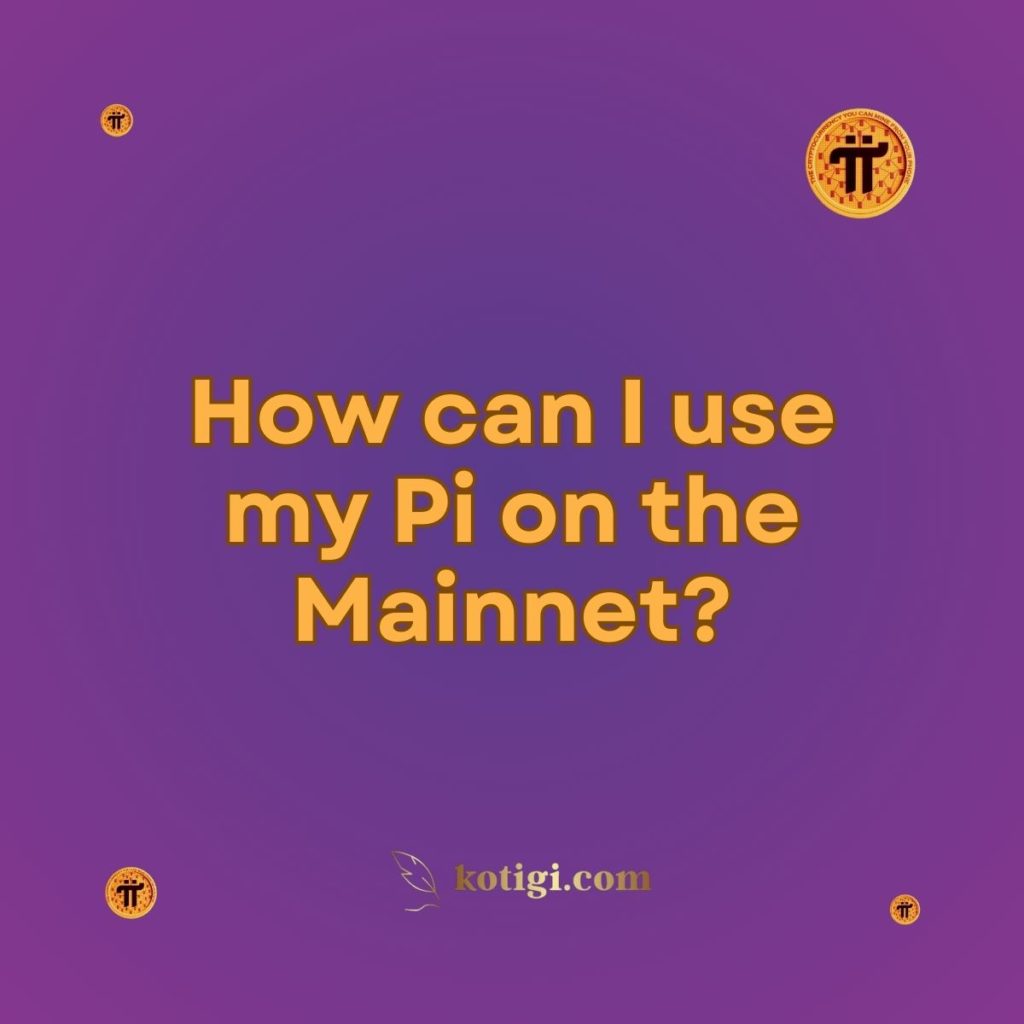
How can I use my Pi on the Mainnet?
Pi Network will officially transition to the Open Network period of Mainnet at 8:00AM UTC on February 20, 2025. Once the Pi Network transitions to the open Mainnet, users will be able to use their Pi coins in various ways, including peer-to-peer transactions, buying goods and services from merchants who accept Pi, trading on exchanges, and interacting with decentralized applications (dApps). The Pi Network aims to create a decentralized ecosystem where users can access digital services and engage in smart contracts, utilizing Pi as the primary currency within its ecosystem.
Introduction
As the Pi Network progresses towards launching its open Mainnet, many users are eager to know how they can use their Pi coins in real-world applications. While the network is currently in its enclosed Mainnet phase, where Pi is still not tradable outside of its ecosystem, the open Mainnet will bring a wide range of opportunities for users to utilize their Pi coins.
In this article, we’ll explore the various ways in which users can use Pi once the open Mainnet is launched, from everyday transactions to participating in decentralized applications (dApps) and accessing financial services within the Pi ecosystem.
What Is the Mainnet, and Why Does It Matter?
Understanding the Enclosed and Open Mainnet
The Mainnet refers to the fully launched version of a blockchain that operates independently of any testing environment. For Pi Network, the Mainnet launch represents the transition from a closed, testing phase to an open, decentralized network where Pi coins can be freely transferred and used in real-world applications.
Currently, Pi is in its enclosed Mainnet phase, which means that Pi transactions are limited to the internal ecosystem and cannot be traded on public exchanges or transferred to external wallets. However, when Pi transitions to the open Mainnet, users will have full control over their Pi coins, with the ability to trade them, use them in transactions, and engage in the broader cryptocurrency ecosystem.
Why Is the Mainnet Important for Pi Users?
The transition to the Mainnet is a critical milestone for Pi Network because it will enable users to use Pi coins for real-world applications, as opposed to simply mining and holding them. The open Mainnet will provide users with the flexibility to send, receive, and trade Pi freely, creating tangible value and utility for the cryptocurrency.
Moreover, the Mainnet will introduce a decentralized environment where developers can create dApps and smart contracts on the Pi blockchain, further enhancing the ways users can interact with and use Pi.
Using Pi for Peer-to-Peer Transactions
Sending and Receiving Pi
One of the most basic and immediate uses of Pi on the Mainnet will be peer-to-peer (P2P) transactions. Users will be able to send and receive Pi coins to and from other Pi holders directly, without the need for intermediaries. This opens the door to using Pi as a digital currency for personal transactions, such as:
- Sending money to friends or family members.
- Paying for goods and services within the Pi community.
- Conducting transactions for digital or physical products.
P2P transactions will be secure and fast, with Pi Network’s blockchain ensuring that transactions are validated and recorded efficiently. As more people adopt Pi and use it in daily transactions, its utility as a digital currency will grow.
Microtransactions and Digital Payments
One of the advantages of Pi is its ability to facilitate microtransactions—small payments that can be used in digital contexts. Whether it’s paying for a small digital service, tipping a content creator, or making an in-app purchase, Pi can be a convenient and cost-effective way to handle these small payments.
Given its low transaction fees and fast processing times, Pi is well-suited for digital micropayments, providing a flexible solution for small transactions in the digital economy.
Using Pi for E-commerce and Goods Purchases
Paying for Goods and Services with Pi
As the Mainnet launches, Pi Network envisions a growing number of merchants who will accept Pi as a form of payment. This will enable users to purchase goods and services both online and offline using their Pi coins. E-commerce platforms and small businesses may integrate Pi as a payment option, allowing users to shop for items such as:
- Electronics, clothing, or household items.
- Digital products like software, ebooks, and subscriptions.
- Services like freelance work, design, or content creation.
Pi Network’s ultimate goal is to establish an ecosystem where Pi is accepted as a legitimate currency for a wide range of goods and services, driving real-world adoption of the cryptocurrency.
Marketplace for Pi Transactions
In addition to traditional merchants accepting Pi, there may also be Pi-specific marketplaces that allow users to buy and sell items directly using Pi. These decentralized marketplaces could function similar to online marketplaces like eBay or Amazon, but with Pi serving as the main currency for all transactions.
Such platforms could provide a valuable opportunity for Pi holders to trade goods and services within a Pi-only economy, boosting Pi’s circulation and utility.
Trading Pi on Cryptocurrency Exchanges
Listing on Public Exchanges
Once the open Mainnet is live, Pi coins are expected to be listed on various cryptocurrency exchanges, allowing users to trade Pi for other cryptocurrencies or fiat money. Trading Pi on exchanges will give users the opportunity to:
- Sell their Pi for profit.
- Buy more Pi to increase their holdings.
- Trade Pi for other digital assets, such as Bitcoin, Ethereum, or stablecoins.
Listing Pi on public exchanges will provide liquidity and create a market for Pi, giving users more flexibility in how they manage their Pi assets.
Speculation and Investment
As Pi becomes tradable, users may choose to hold Pi as an investment, hoping for its value to increase over time. Like any cryptocurrency, the price of Pi will be determined by supply and demand, as well as the overall success of Pi Network in driving adoption and use cases.
While some users may opt to sell their Pi for short-term gains, others may choose to hold onto Pi long-term, anticipating future growth in its value as the network expands and more businesses adopt Pi as a payment method.
Using Pi in Decentralized Applications (dApps)
What Are dApps?
Decentralized applications (dApps) are software applications that run on blockchain networks rather than centralized servers. They provide a range of services, from financial applications (DeFi) to gaming, social media, and online marketplaces. Pi Network plans to support the development of dApps on its blockchain, allowing developers to build innovative solutions that use Pi as the primary currency.
Engaging with dApps on the Pi Network
Once Pi transitions to the open Mainnet, users will be able to interact with dApps built on the Pi blockchain. These dApps could include:
- Decentralized financial services (DeFi): Lending, borrowing, staking, and earning interest on Pi holdings.
- Online marketplaces: Platforms where users can buy and sell digital or physical goods using Pi.
- Gaming and entertainment: Games and apps that use Pi for in-game purchases or rewards.
- Social media and communication: Decentralized platforms that reward users for engagement with Pi coins.
By supporting dApps, Pi Network aims to create a decentralized economy where Pi is used not only for transactions but also as a means of participating in the broader digital ecosystem.
Using Pi for Smart Contracts and DeFi
Smart Contracts on Pi Network
Smart contracts are self-executing contracts where the terms of the agreement are written into code. These contracts automatically execute when predefined conditions are met, removing the need for intermediaries.
Pi Network plans to support smart contracts on its blockchain, enabling a wide range of decentralized services. These could include:
- Automated financial transactions: Users can set up recurring payments, escrow services, or lending agreements.
- Business contracts: Companies can use smart contracts to automate and secure their agreements, reducing the risk of fraud or disputes.
- Tokenization: Users can create and trade tokenized assets, representing anything from real estate to digital art, using Pi.
Smart contracts will significantly increase the utility of Pi by enabling complex financial transactions and agreements to be executed automatically and securely.
Decentralized Finance (DeFi)
Pi Network’s smart contracts will also support DeFi applications, allowing users to participate in decentralized financial services without relying on traditional banks or financial institutions. DeFi on Pi Network could include:
- Lending and borrowing: Users can lend their Pi coins to others in exchange for interest or borrow Pi without needing a traditional loan.
- Staking and yield farming: Users can stake their Pi to earn rewards or participate in yield farming opportunities within the Pi ecosystem.
DeFi will open up a whole new realm of possibilities for Pi holders, providing them with access to financial services that are decentralized, secure, and efficient.
Conclusion
The Pi Network Mainnet will bring a host of exciting opportunities for users to utilize their Pi coins in various real-world applications. From peer-to-peer transactions and e-commerce to decentralized applications and financial services, the open Mainnet will unlock the full potential of Pi as a decentralized cryptocurrency.
As the network continues to grow and more developers build on the Pi blockchain, users will have even more ways to interact with the Pi ecosystem. Whether it’s buying goods, trading on exchanges, or participating in DeFi, the utility of Pi is set to expand significantly as the Mainnet launches.
Key Takeaways:
- Users will be able to send and receive Pi through peer-to-peer transactions on the Mainnet.
- Merchants and marketplaces will begin accepting Pi as a form of payment for goods and services.
- Pi will be listed on cryptocurrency exchanges, allowing users to trade it for other cryptocurrencies or fiat money.
- Users can engage with decentralized applications (dApps) built on the Pi blockchain.
- Pi Network will support smart contracts and DeFi applications, providing access to decentralized financial services and automated contracts.





